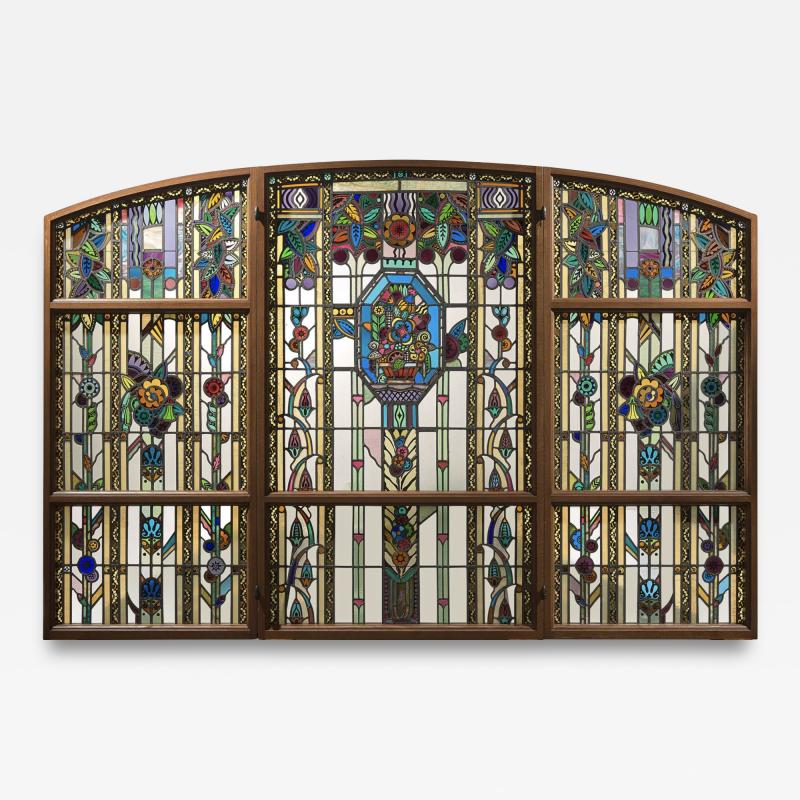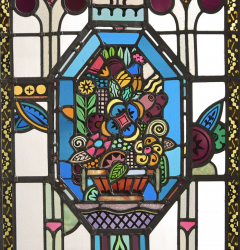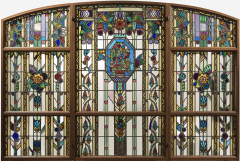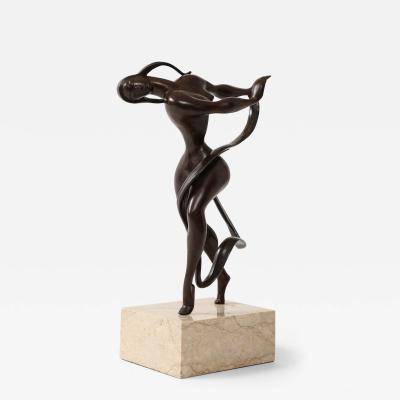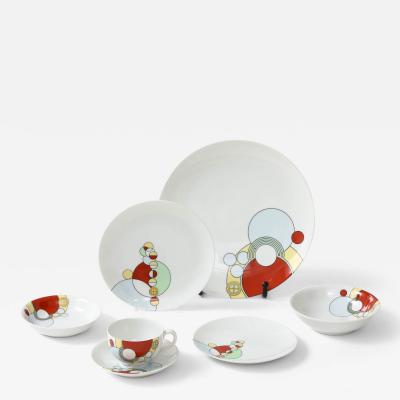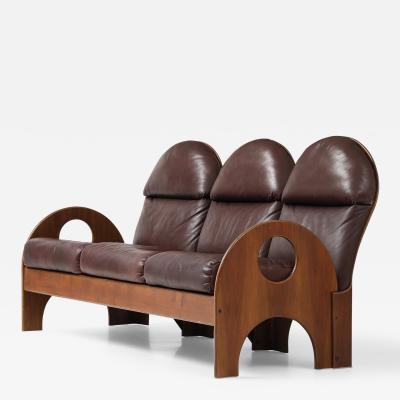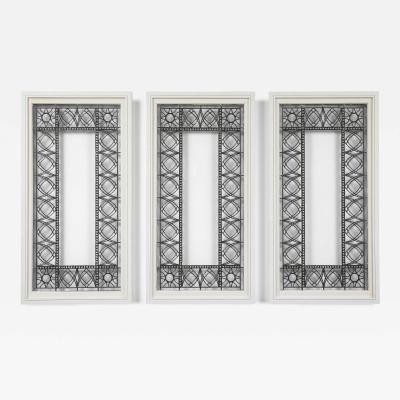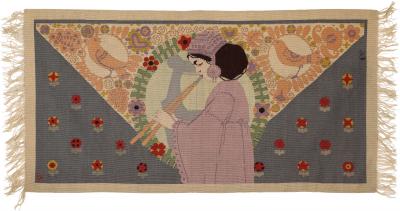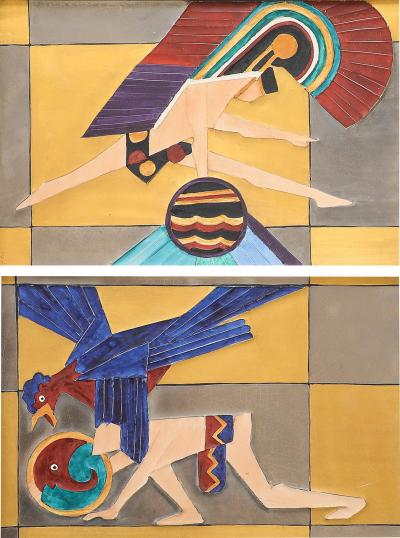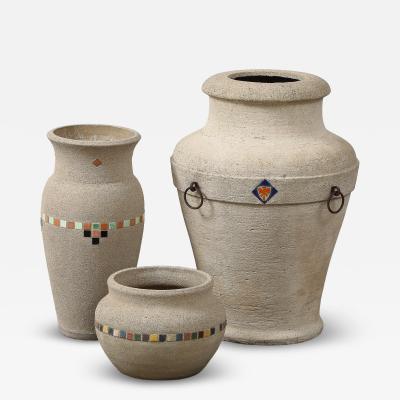Chestnut Street Window
-
Description
A unique and luminous monumental stained-glass window designed and executed by Nicola D’Ascenzo (1871-1954), one of the most important stained-glass designers and fabricators from the first decades of the twentieth century. D’Ascenzo’s oeuvre radically departs from the work of Louis C. Tiffany, John LaFarge and traditional stained-glass designers in its bold tonalities, geometric patterning, and a purposeful rejection of naturalistic details and recession into space. In the Chestnut Street Window D’Ascenzo created a decidedly modern window in a centuries-old technique. Diversely colored and whimsical, this 8 paneled window, featuring stylized floral and leaf motifs, was originally installed at the Horn Building, at the corner of 16th and Chestnut Streets in Philadelphia. The Art Deco architect, Ralph B. Bencker, designed the building for restaurant innovators Joe Horn and Frank Hardart, and it opened in the late 1920s. It housed Horn & Hardart’s corporate offices and a signature Horn & Hardart eatery. By this time, D’Ascenzo had been working with Horn & Hardart for over a decade, and for this commission his studio produced several two-story windows for the entranceway and the side façade.
Known for the high quality of his craftsmanship, D’Ascenzo masterfully manipulated hand-blown, antique, opalescent and other glass in a wide range of saturated colors and textures. He was also known for varying the size of the lead cames between the glass, resulting in a sophisticated and complex composition. Here, strong vertical elements, in a limited palette, are counterbalanced by overlapping circular motifs, bursting with color, suggesting bouquets of assorted flowers. Star shapes, squiggles, stylized open and closed buds and leaves all contribute to the playfulness of the image. Enclosed in a medallion, a basket of blooms dominates the central section, while vines and geometrical designs enliven the large areas of clear glass. Indeed, D’Ascenzo’s zones of clear glass differentiate his work from other glass artists’ windows. Combined with his strong lead lines, the balance between color and transparency imbues his work with a fresh and novel quality.
Nicola D’Ascenzo was born in Italy in 1871 and came to the United States when he was eleven years old, settling in the Germantown section of Philadelphia. D’Ascenzo studied at the Pennsylvania Museum School of Industrial Art, the Pennsylvania Academy of Art and the New York School of Design. In Philadelphia, D’Ascenzo set up a studio initially for portrait painting and interior design, but he soon became interested in stained glass. D’Ascenzo traveled to Europe, specifically to France and England to study the best examples of medieval stained glass. Wanting to control the production as well as the design, he opened a much larger studio based on a medieval guild, during the 1920s. Philosophically, D’Ascenzo valued the collaboration with every artist in the studio and it was known for the camaraderie of its members and their profit sharing. He extended the respect he felt for his team to his clients and all viewers of his work. D’Ascenzo created stained glass at every price point, rejecting the idea that only the wealthy would have access to high quality and beauty. D’Ascenzo’s art was “Art for humanity’s sake.” In this regard, his partnership with Horn & Hardart was ideal. The chain was beloved for their consistently fresh and inexpensive food, served in a democratic setting, and their embrace of new technologies. The Chestnut Street Window is the superb outcome of partnering two American innovators, Horn & Hardart and Nicola D’Ascenzo.
As the first half of the twentieth century witnessed a building boom in Neo-Gothic churches and university campus buildings, D’Ascenzo Studios met with enormous success with projects for windows, mosaics, and mural painting across the country. Among the most well-known commissions were windows for the Folger Shakespeare Library (Washington, DC); the National Cathedral (Washington, DC), the Cathedral of St. John the Divine (New York City), and the Washington Memorial Chapel (Valley Forge, King of Prussia, PA). In addition to the many residential and commercial commissions, D’Ascenzo designed stained glass for dozens of the extraordinary and popular Horn & Hardart locations in New York and Philadelphia. The studio’s incredible success can be attributed to D’Ascenzo exquisite designs, gorgeous and meticulously crafted glass fabrication and selection, and the modern interpretation of his subjects.
Restoration Project
The Horn building was demolished in 1966. At least two of D’Ascenzo’s windows were saved. One is currently in the collection of the Woodmere Art Museum, Philadelphia, and the other is this example. Over the past eight months, the Chestnut Street Window was conserved by Chandler V. Coleman of Cathedral Stained Glass Studios outside of Philadelphia. Coleman, an artist from a young age, grew up in Philadelphia and apprenticed with Kenneth A. Crocker, an English master craftsman who came to the United States to work for the Willet Stained Glass Studios. From the age of 11, Coleman spent his spare time learning about types of glass, designing, cutting, painting, soldering, cementing, firing, framing, and installing stained glass. In 2000, he bought Cathedral Stained Glass Studios, an incredibly rich resource of antique glass made in America and imported from Europe, opalescent, and other machine-made art glass. Over the past months, Coleman has meticulously restored D’Ascenzo’s window. Before beginning his work, Coleman painstakingly created rubbings of each section, color-coded to note the complex array and widths of the lead cames – a D’Ascenzo signature. Then he carefully followed the intricate pattern, replacing broken pieces with period glass, hand-painting sections, replacing the lead cames, soldering and cementing. Each of the eight sections were fired independently and then fitted into the custom-made frame. Coleman also restored the related window in the Woodmere Art Museum. As a result of Coleman’s skill, knowledge, and love of his métier, these D’Ascenzo windows have been brought back to their original translucent brilliance.
The Nicola D’Ascenzo archive and the archive of D’Ascenzo Studios are held at the Athenaeum, Philadelphia. There are 418 of his projects catalogued in the archive. -
More Information
Documentation: Ample Provenance Origin: United States, Pennsylvania Period: 1920-1949 Materials: Leaded Stained Glass Condition: Good. Original glass with restored leading, solid wood frame is new for display Creation Date: 1926 Number of Pieces: 8+ Styles / Movements: Aesthetic Movement, Bohemian, Traditional 200 Lex Booth #: 35 Patterns: Florals/Botanical, Geometric, Modern, Stripes & Solid, Traditional Article References: https://woodmereartmuseum.org/explore-online/collection/untitled-stained-glass-window Incollect Reference #: 745069 -
Dimensions
W. 128.875 in; H. 88.125 in; D. 3.5 in; W. 327.34 cm; H. 223.84 cm; D. 8.89 cm;
Message from Seller:
This revolutionary space showcases over 50 of the finest antique and vintage dealers, who present an extraordinary mix of antique, vintage, and 21st Century finds – furniture, accessories, lighting, fine art, and fine jewelry. We are an all-inclusive design resource for both designers and consumers THE GALLERY AT 200 LEX: MONDAY – FRIDAY 9:30 AM – 5:30PM FOR MORE INFORMATION CALL 646-293-6633 OR EMAIL THEGALLERY@NYDC.COM
AVAILABLE AT:
The Gallery at 200 LEX














